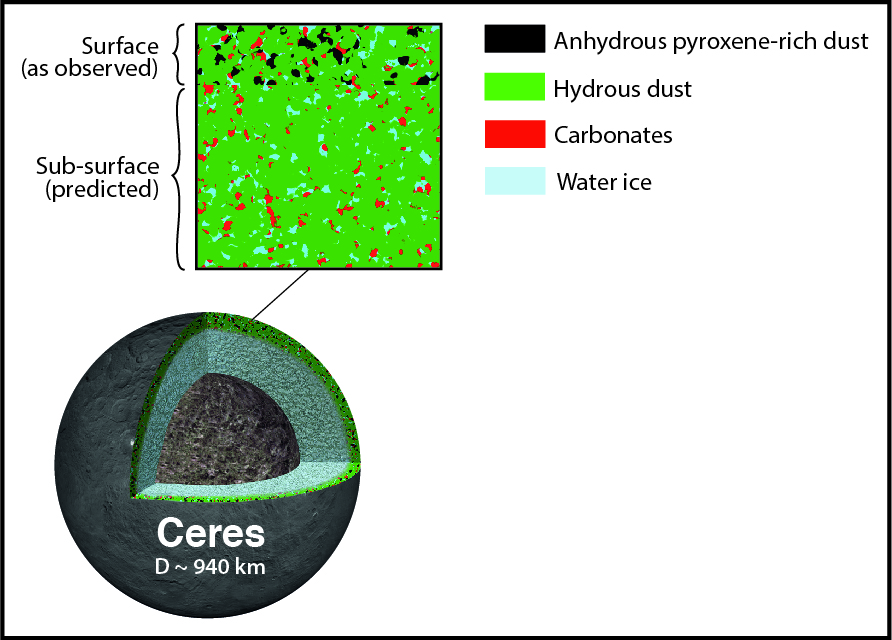“When it comes to asteroids, we shouldn’t judge these objects by their covers”, it is the message of Franck Marchis, the senior planetary astronomer at the SETI Institute. After the mid-infrared observation data from SOFIA (NASA’s Stratospheric Observatory for Infrared Astronomy) have shown Ceres’ true composition, the scientists think that asteroids and dwarf planets, like Ceres, can be camouflaged.
Using the data primarily collected by SOFIA, the team of scientists has detected something strange in the outer layer of Ceres’ surface. Tha data show the layer is made of the materials that seem to be fragments of other asteroids containing mostly rocky silicates.
“We find that the outer few microns of the surface are partially coated with dry particles,” Marchis says. “But they don’t come from Ceres itself. They’re debris from asteroid impacts that probably occurred tens of millions of years ago.”

The column of material at and just below the surface of dwarf planet Ceres (box) – the top layer contains anhydrous (dry) pyroxene dust accumulated from space mixed in with native hydrous (wet) dust, carbonates, and water ice. (Bottom) Cross section of Ceres showing the surface layers that are the subject of this study plus a watery mantle and a rocky-metallic core.
Credits: Pierre Vernazza, LAM–CNRS/AMU
It was commonly believed that Ceres, the only dwarf planet in our solar system and the largest body in the asteroid belt between Mars and Jupiter, was the carbon-rich surface planet. Based on the previous data gained from the ground-based telescopes, astronomers classified Ceres as well as 75% of all asteroids, in composition class “C”. The similar color of Ceres’ and other asteroids was the physical feature that put them into the same class.
But the new findings are challenging the conventional understanding of the relationship between Ceres and smaller asteroids. Only the mid-infrared observations made using SOFIA were able to show the true Ceres’ composition.
“SOFIA, with its airborne location and sensitive FORCAST instrument, is the only observatory, currently operating or planned, that can make these kind of observations,” Marchis explained. “These and future mid-infrared observations are key to understanding the true nature and history of the asteroids.”
The study, published January 16, 2017 in the Astronomical Journal, resolves a long-standing question about whether surface material accurately reflects the intrinsic composition of an asteroid.

SOFIA, so-called The Flying Observatory, used mid-infrared light to gain information on Ceres. Image Credits: NASA
“By analyzing the spectral properties of Ceres we have detected a layer of fine particles of a dry silicate called pyroxene. Models of Ceres based on data collected by NASA’s Dawn as well as ground-based telescopes indicated substantial amounts of water-bearing minerals such as clays and carbonates”, said Pierre Vernazza, research scientist in the Laboratoire d’Astrophysique de Marseille (LAM–CNRS/AMU) and study co-author.
The findings could help scientists to better understand our solar system and its elements, and objects correlations in the universe.
SOFIA, the largest airborne observatory in the world, is actually a Boeing 747SP jetliner modified to carry a 100-inch diameter telescope, based in California. It is a joint project of NASA and the German Aerospace Center, DLR.



